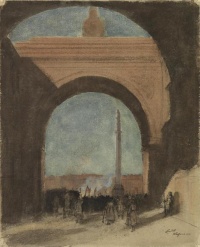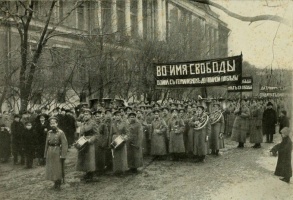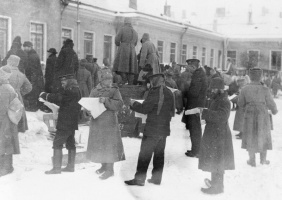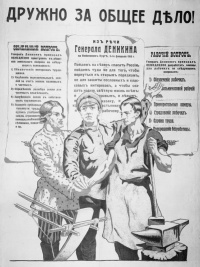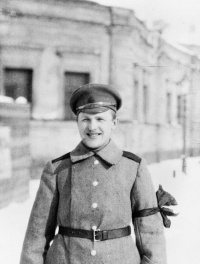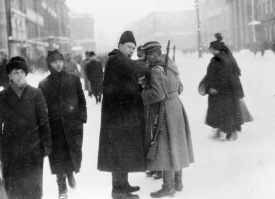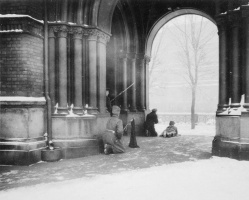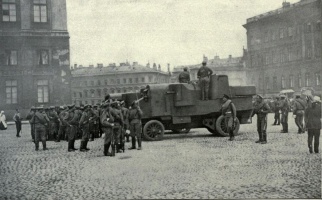From War to Revolution: 1914–February 1917↑
The onset of war appears to have temporarily united the often-conflicting nations and classes of the Russian Empire. Mobilization was met with hostility which was often also connected with the simultaneous banning of most alcohol sales and the fact that it coincided with the harvest. By and large, however, social unrest subsided. Once the initial successes had turned into defeats, the first rents in the social fabric began to appear. Retreat, refugees and deportations caused chaos from early 1915 on.[1] The home front also saw signs of rising instability. The number of strikes began to increase in 1915. Many of these disturbances took on a xenophobic form. In Moscow, factories were burned down in a series of anti-German riots.[2] In Kostroma, striking women textile workers claimed that German prisoners were better supplied than they were themselves.[3] Soldiers’ wives were an increasingly prominent component of demonstrations, demanding material support and compensation for the lost labour of their absent husbands.[4] In the face of the growing internal and external crises, the previously supine Fourth Duma, a kind of parliament with very restricted powers and elected on the basis of a highly unequal franchise which gave preference to property owners, began to worry that if the apparently impending cataclysm was not averted, they would be dispossessed by revolution from below. They believed it would be possible to prevent social unrest by enacting political reforms. In August 1915 the majority of the Duma and certain members of the ultra-conservative State Council formed a Progressive Bloc committed to establishing basic constitutional rights, including equality for all national and ethnic groups. In particular, they wanted to create a government that had the confidence of the people.[5] Nicholas II, Emperor of Russia (1868-1918) dismissed all such claims and sacked most of his ministers when they urged him not to follow his favoured solution to the crisis – taking over personal command of the army from Nicholas Nikolaevich, Grand Duke of Russia (1856-1929). Despite some brief success enjoyed by the armed forces later in 1916, the August 1915 crisis set the scene for the final decline of the autocracy. From August onwards the Duma was marginalised, and the official government became increasingly inept and subject to capricious interventions by the tsar. Russia was virtually a military dictatorship. Nicholas II was happy with this situation but few others were. The dangerous political incompetence of the High Command was noticed and feared.[6] By the end of 1916, secret police reports became increasingly alarming, even suggesting that aspects of the situation were worse than in 1905.[7] There were widespread but unfounded rumours that a pro-German party existed in the highest court circles, centred on the German-born Aleksandra, Empress, consort of Nicholas II, Emperor of Russia (1872-1918). Tsarism was in its death throes.
The end came rapidly and unexpectedly. Early accounts of the final crisis emphasised the spontaneous nature of the final collapse in the February Revolution.[8] The populace of the capital, under pressure of declining wages and severe food shortages, embarked on a series of strikes and street demonstrations. The turning point, according to this interpretation, came on 26 February when troops sided with the crowds and fired on the police. (All dates are according to the Russian calendar.) At this crucial moment the authorities hesitated, the mutiny spread, and the authorities lost control of the city. The Duma hesitantly formed a Provisional Committee (27 February) and eventually the Provisional Government based on the Progressive Bloc (2 March). One of its first acts was to demand that Nicholas II abdicate in the hope that it might appease the demonstrators and return control of the situation to the elites. This aspiration failed utterly even though the tsar did abdicate (2 March). As a consequence, the monarchy collapsed and the Duma faced a rival in the form of the fledgling Petrograd Soviet, which emerged on 27 and 28 February.
Although still widely accepted, this interpretation has raised questions. In particular, having fought off almost the entire society for over a year in 1905, why did the monarchy crumble after a few days of pressure in one city? To answer this, scholars have begun to examine the role of elites.[9] In this interpretation, the immediate cause of Nicholas’ abdication was not pressure from the streets but telegrams from six of the seven front commanders demanding his abdication. Acting in concert with Duma leaders, they were motivated by the parlous state of the country with respect to the war. They believed that sacrificing Nicholas would re-energise the country for a more successful war effort.[10] However, such was their ineptitude that, in the short term, they had not prepared the ground for the next step and many of the elite revolutionaries were taken aback by the refusal of Nicholas’s brother, Mikhail Alexandrovich, Grand Duke of Russia (1878-1918), to assume the throne. The monarchy collapsed by default. Under relatively light pressure, the Russian state had begun to implode and the pressures generated by Russia’s long-term problems of economic and social "backwardness",[11] began to break out into the open. Instead of stopping revolution, the February incompetents had opened it up.
From February to the October Revolution↑
The period from the collapse of the monarchy to the Bolshevik takeover less than eight months later can be characterised as one in which a complex, widening set of interacting revolutions emerged and developed. The main driving force was a popular movement comprising peasants, workers, soldiers, and sailors who began to assert their rights and demands through a vast network of for the most part spontaneously organised committees. The overwhelming majority of the population was associated with this movement in one form or another. However, the situation was further complicated, not least by the fundamental divisions within the elites, which had opened up the path to revolution. Landowners and the broad capitalist class – which also included most of the professional, managerial, and technical elite – shared a common defence of property, but there were serious divisions over how that should be achieved. The right demanded "order" through firm authoritarianism and, if necessary, a military dictatorship. Liberals sought to establish a form of representative democracy. In addition, there was an increasing number of national revolutions, with Finns, Poles and, more ambiguously, Ukrainians in the forefront. By the end of 1917, many more national minorities were undergoing complex revolutions of their own in which the nationalist foundation was expressed through right, centre and left-wing forces ultimately in conflict, not only with each other, but also with the Russian metropolis and often with neighbouring nationalities as well. Add to this the crucial social revolutions, with gender revolution as an important component, as well as cultural and religious revolution,[12] and the period takes on a massive complexity. It has been rightly called a "kaleidoscope of revolutions".[13]
The February Revolution produced two foci of national power. The Provisional Government (PG) was formed out of the Progressive Bloc of the Fourth Duma and adopted its western-style democratic and civil rights agenda, at least in theory. It was composed initially of liberals and the centre-right and represented primarily capitalist and landholding property owners. It was committed, by its founding programme and an agreement with the Petrograd Soviet of Workers’ Deputies, to holding elections for a Constituent Assembly and defending Russia more effectively. It should be noted that the February Revolution was based less on calls for peace than for a more successful prosecution of the war, at least to defend Russia. The Petrograd Soviet, which as its name suggests was a local organisation, nonetheless came to be a national focus of the left. Though initially expected to be composed predominantly of workers, in fact from the outset soldiers and sailors made up its main component, a fact reflected in the rapid change of its name to the Petrograd Soviet of Workers and Soldiers’ Deputies. Nonetheless, its senior leaders were drawn mainly from radical intellectuals who led left-wing political parties. The parties in the Soviet were all socialist with a few anarchists at the fringe. Initially, the Soviet forbade its members from participating in the PG. The only exception was Alexander Kerensky (1881-1970), a young, radical lawyer who was appointed Minister of Justice, his main task being to prepare the prosecution of the Tsar.
It has been suggested that there was a form of dual power as a result of the emergence of two political forces. However, this was not the case in that the Soviet clearly recognised the PG as the government and saw itself as a pressure group, not a political alternative. As time passed, the political distinctions became blurred as Soviet-based parties were sucked into joining the PG, which evolved through a series of coalitions.[14] Their main reason for joining the PG was to maintain national unity and avoid civil war which would likely result in occupation by the armies of the Central Powers. The process caused massive tensions in the left-wing parties, which began to split into warring left and right factions. The former supported the PG to the end, the latter increasingly called for Soviet power. In brief, Russia’s internal political evolution between the revolutions was driven by two interrelated forces: radicalisation among the peasants, workers, soldiers, and sailors – the popular movement – which led to the polarisation of the propertied elites and the masses. Centrist forces, like the PG and Kerensky, who tried to maintain national unity, were increasingly isolated.
Phases of revolution in 1917↑
Within this complexity, it is possible to observe several distinctive phases. In the first phase, an initially stuttering radicalisation took on greater momentum. In July, the radicals overstepped the mark and opened up the way for the elites to briefly take the initiative. When, in late August and September, they too overstepped the mark, the path was opened for the twin soviet and Bolshevik takeover in the form of the October Revolution.
Early radicalisation March to July↑
The February revolution had united a wide spectrum of the country behind its twin goals of overthrowing Nicholas and thereby helping Russia to defend itself. From the beginning, the honeymoon proved unstable and conflicting forces soon emerged. It is vital to note that the weakening of the authority of the state that was brought about in February opened the way to the social revolutions so fiercely repressed by the autocracy. Initially peasants encroached gradually on landowners’ land and prerogatives. Theft of firewood, poaching, pasturing animals on landowners’ land, rent reductions, and sowing grain on fallow land were characteristic of the early stages. By the middle of the year, peasants were exerting a form of veto on the management of estates. Starting from the assumption that the farms would soon be transferred to them legally, they stepped in with increasing frequency to prevent landowners from stripping farm assets. In the cities, workers’ main concerns were better wages and conditions. Shortly after the February Revolution, employers were forced to concede the eight-hour day and to pay substantial wage rises. Pressure for war production and the ever-raging fire of inflation – a crucial component of the pressure for revolution and an indirect but massively influential consequence of the war – soon swallowed up the gains, leading to a new round of strikes. For soldiers and sailors, the main issues were military discipline and peace, which for many of them had an obvious direct implication – their lives hung on these questions. In addition to their diversity, the three branches of the popular movement shared a desire for self-representation which expressed itself through the establishment of a bewildering set of committees and organisations. Local soviets, trade unions and political party membership proliferated. Peasants set up village and parish committees, workers set up factory committees, military personnel set up regimental and battleship committees. Eventually, many of these were linked on a local and regional basis, the most important being the army and front committees in the military. The result was a vibrant, if not very coherent, set of popular institutions. A second unifying factor was a growing sense that the popular movement – the narod, the people – shared values based on social justice in contrast to the privileges of the propertied elite, referred to by the term burzhui, a corrupted version of the word bourgeois. A distinct ‘us’ and ‘them’ class consciousness rapidly emerged in the early months.
From the July Days to the Kornilov Mutiny↑
The propertied classes had been in turmoil since the February revolution; their concerted effort to stop further development of the revolution had unravelled in spectacular fashion. The institutions on which they had relied – the monarchy and the Duma – had disintegrated within days. As its very name suggested, the Provisional Government was living on borrowed time. The armed forces were politically divided. The rank and file were siding with their worker and peasant brothers and sisters. Many conscripted officers, especially those from intelligentsia circles, such as medics, vets and engineers, were more sympathetic to the left than to the right. Right-wing officers were becoming an isolated minority in the army. Nonetheless, despite the emergence of pressure groups, like the Union of Landowners and Union of Towns, conservative army and navy officers remained the most resolute and powerful force on the right. Their first objective was to roll back what they saw as the lack of discipline of the army, exemplified by the committees. Both Kerensky, Minister of War since April, and the first Commander-in-Chief, General Mikhail Alekseev (1857-1918), prevented right-wing officers, like General Lavr Kornilov (1870-1918), who was himself appointed Commander-in-Chief on 19 July, from embarking on a suicidal direct assault on the committees. Instead, it was agreed that an offensive would re-establish discipline and morale. Such a plan directly contradicted the central principle of the soldiers’ committees – to fight if Russia were attacked but not to support an offensive, since offensives were reckless with participants’ lives. The offensive duly took place in Galicia in June. Not surprisingly, it was a disaster, which made the situation infinitely worse. To add fuel to the flames, the PG and army command tried to use the moment to transfer radical troops out of Petrograd in express contravention of agreements between the government and the Soviet. The attempted transfers provoked armed resistance and, for a couple of days in early July (3-7 July), the PG was at the mercy of armed sailors from the Kronstadt naval base and their worker and soldier allies in the capital. Only the refusal of all left-wing parties – including the as yet still fairly marginal Bolshevik party led by Lenin – to lead an overthrow saved the PG for the moment.
The hesitancy of the left was a gift to the PG and the right. Kerensky, who emerged as Prime Minister at the head of the Second Coalition Government, seized the initiative. The Bolsheviks were spuriously accused of undermining the offensive on instructions from Germany. Their press was shut down. Vladimir Lenin (1870-1924) left hurriedly for Finland. Leon Trotsky (1879-1940) turned himself in to the authorities arguing they would not be strong enough to hold him for long. The right had turned its own defeat into a victory. For the next two months the left was in retreat and the right began to assert itself. Troops were called in more frequently to counter the excesses of the peasants. Right-wing lobbies began to pressure the PG. Above all, Kornilov became the focus of extremists who urged a military coup. By the middle of August, following a State Conference held in Moscow as a preliminary to the much-delayed Constituent Assembly, Kornilov’s star was in the ascendant. His programme, outlined at the State Conference by one of his associates, General Aleksej Kaledin (1861-1918), consisted mainly of suppressing the committees, extending martial law to the railways and major factories, and re-introducing the death penalty, which had already been reinstated at the front. What happened next remains unclear in terms of details but crystal clear in terms of consequences. In late August, Kornilov moved troops towards Petrograd, ostensibly to suppress the Petrograd Soviet. However, Kerensky’s suspicions were aroused by an informer who claimed Kornilov actually intended to overthrow the PG and declare himself Head of Government. In an almost farcical incident, Kornilov appeared to confirm Kerensky’s suspicions without clarifying what they were. Kerensky had him arrested and made a deal with the Petrograd Soviet, which included arming them and releasing political prisoners, including Trotsky, whose prophecy was thereby fulfilled. A delegation was sent out which successfully talked Kornilov’s troops out of continuing their assault. The right was in complete disarray.
The October Revolution↑
The Kornilov affair created a power vacuum. The immediate threat of a military coup had become non-existent. However, the PG also became almost powerless. Supporters on the right, especially the crucial officers, hated Kerensky for his apparent betrayal of Kornilov. However, Kerensky gained no corresponding credit with the Soviet because he was tainted by his initial collaboration with Kornilov. The process of dissolution of power that began in February, had reached its lowest point. Central power and authority had been dissipated. The popular movement reacted to the attempted military coup with a defensive radicalisation. Having assumed, perhaps naively, that their great goals would inevitably be achieved, the Kornilov affair showed they were, in fact, under threat. To defend the gains of February, they re-asserted their initial objectives. Most important, the first big wave of peasant land seizures began in September and October, also provoked by a "now or never" reaction to the Kornilov affair.
One person above all others immediately grasped the significance of the moment. From his safe house in Helsinki, Lenin began a campaign to urge his party to take power in the name of the soviets. The Bolshevik Central Committee was mystified and alarmed by Lenin’s new determination. Up to that point, there had been no talk of a Bolshevik bid for power. Apart from Lenin’s boast in June that the party was ready for power, his actual policies, in the July Days for example, had emphasised caution. On his return from exile, he had proclaimed his April Theses, which set out the foundation of his policies for 1917.[15] Regardless of whether or not Lenin truly foresaw its implications from the beginning, the most important provision in the medium term was one in which he enjoined the party to give no support to the PG. This was obviously not a call for its immediate overthrow, but the effect was to keep the Bolsheviks out of any collaboration with the PG. As the leading groups of other Soviet parties, notably the Socialist Revolutionaries (SRs) and the Mensheviks, were sucked into the PG as it recruited the left into successive coalitions, the Bolsheviks remained the only consistent critics of the PG. Since the government had failed to deliver on its promises of democracy, stabilisation of urban living standards and land redistribution, and was deaf to the increasing calls for a more energetic peace policy, its popularity had declined, dragging the SRs and Mensheviks down with it. The dissident minorities of those parties – the left SRs and the Menshevik Internationalists – came closer to the Bolsheviks. Free from the responsibility of governing, the Bolsheviks trimmed their sails to the winds of the popular movement. They adopted its slogans of peace, bread, land to the peasants and all power to the soviets, even when they contradicted fundamental Bolshevik principles. In addition, they were highly adept at getting these ideas across to the masses and exploiting the indecisiveness of the Provisional Government, especially on the key questions of war and land.[16]
As late as the Kornilov affair, only seven weeks before they came to power, there was little sign that the Bolsheviks were destined to take over. Across 90 percent of the country, they were hardly known. However, their support was concentrated in the crucial areas of the major cities and military units of northwest Russia. Indeed, part of Lenin’s excitement was generated by the fact that on 31 August, for the first time, the Petrograd Soviet had supported a key Bolshevik proposal and elected a new executive committee with a Bolshevik majority. The Moscow Soviet had also turned towards the Bolsheviks (5 September). Their support grew rapidly in August and September, largely the result of voters and supporters switching from the previously more popular Mensheviks (and, to a lesser extent, SRs). Despite this, Lenin had to make extraordinary efforts to persuade his fellow party leaders to share his enthusiasm for seizing power. His cascade of letters from Helsinki was so ineffective that he emerged temporarily from hiding to participate in two momentous meetings of the Bolshevik Central Committee. The first, on 10 October, put armed uprising on the agenda. The second, on 16 October, showed that little had been done to further an uprising, that there was still some opposition to it among the leaders, and that there was no clear support for an uprising among the party’s key supporters.[17] The actual seizure of power bypassed the Central Committee and was largely conducted by the Petrograd Soviet through its Military Revolutionary Committee (MRC). Originally set up to defend the city in the event of desertion by the PG or an attack by the German army, it was converted into an improvised organ for the seizure of power.
In the face of the gathering storm of defensive militancy among the masses and declining state power, Kerensky chose to try to maintain national unity at a time when rapid polarisation was destroying it irreversibly. Had he sided with the Soviet, there is no knowing what the outcome might have been. However, his decision to try to prevent the Second Congress of Soviets from meeting as scheduled turned out to be self-destructive. The meeting was postponed as the crisis grew. On 24 October, government troops took over the Bolshevik press in Petrograd. Troops were then sent out to take control of the city’s strategic points. This provoked Soviet countermeasures. On 24 October, the MRC ordered its forces to take over the strong points from government troops, usually by persuasion. In the midst of this, Lenin emerged from his Petrograd safe house and around the time of his arrival at Soviet headquarters in the Smolny Institute late on 24 October, coincidentally or not, the defensive action turned into attack. Soviet forces took over key government buildings including the headquarter of the Petrograd Military District. Later, on the evening of 25 October, they infiltrated the Winter Palace and arrested the ministers. But Soviet power had already been declared on the morning of the 25 October in a declaration drafted by Lenin. As one commentator said, the Bolsheviks had not so much seized power, as found it lying in the streets and picked it up.[18] It was one thing to declare Soviet power. But could it be truly constructed and defended?
Conclusion↑
Revolution had been incubating in Russia for at least half a century before 1917. New social, intellectual and political forces associated with industry, capitalism and modernisation were being held back by an anachronistic political system which had evolved to police a serf society that no longer existed. The war did not create this dangerous situation but it did a great deal to unleash the Revolution. In 1917, the social revolution was set off by the collapse of the state. The latter had been unwittingly set in motion by an inept attempt to pre-empt the deeper revolution. Nonetheless, the war had a massive impact on the course of the revolution. Without it, the state would not have weakened in the way it did. Once social revolution had begun, the chief actors included armed revolutionary soldiers and sailors, who represented the main physical force behind it. Additional problems arising from the war, with inflation the most potent, fuelled almost universal protest from the masses. Dealing with the war had a major impact on national politics and split the major parties of the left, leaving a formerly marginal Bolshevik party to lead those in opposition to war and to the sinking Provisional Government. The war continued to make its mark on the emerging Soviet system for another three bitter years of civil war. It was also the case that Joseph Stalin (1879-1953) and many of those around him were inspired by the war years. The Soviet system’s martial birthmark was visible up to its end, in its authoritarianism, its productionist, heavy-industry-oriented economy, and its vast military.
Christopher Read, University of Warwick
Section Editors: Boris Kolonit͡skiĭ; Nikolaus Katzer
Notes
- ↑ Over 3 million refugees poured eastward, supplemented by forced deportations. Altogether, the war created some 6 million displaced civilians. Gatrell, Peter: A Whole Empire Walking. Refugees in Russia during World War 1, Bloomington et al. 1999, p. 3. In particular, Jews were affected by these processes and some desperate army officers and commanders often diverted blame for the military reverses from themselves by making Jews scapegoats. Cherniavsky, Michael: Prologue to Revolution. Notes of A.N. Iakhontov on the Secret Meetings of the Council of Ministers 1915, Englewood Cliffs 1967, p. 68.
- ↑ Lohr, Eric: Nationalizing the Russian Empire. The Campaign against Enemy Aliens in World War, Cambridge, MA 2003, pp. 31-54.
- ↑ Daly, Jonathan/Trofimov, Leonid: Russia in War and Revolution 1914-22. A Documentary History, Indianapolis et al. 2009, pp. 10-11.
- ↑ Badcock, Sarah: Women, Protest and Revolution. Soldiers Wives in Russia in 1917, in: International Review of Social History 49 (2004), pp. 47-70.
- ↑ They did not call for democracy, a parliament or equal mass voting. The formula was intended to suggest a compromise government supported by Tsar and Duma. Essentially, it was a coded call for the Duma to have access to real power.
- ↑ Cherniavsky, Prologue 1967, p. 68.
- ↑ Vernadsky, George/Pushkarev, Sergei A.: Source Book for Russian History from Earliest Times to 1917, Princeton 1972, vol. 3, pp. 865–866.
- ↑ William H. Chamberlin, originally writing around 1930, set the precedent by calling it one of the most spontaneous revolutions of all time. Chamberlin, William Henry: The Russian Revolution, 2 vols, New York 1965, p. 63.
- ↑ One of the first to do this was George Katkov. Although his general conspiracy theory about the February revolution has few supporters, his study of the actions of the elites, especially the senior staff officers of the army and its front commanders, opened the way to modifications of the theory of spontaneity. Katkov, George: Russia 1917. The February Revolution, London 1967.
- ↑ Rapid recognition of the new government by the United States (9 March) and Britain and France (11 March) has fuelled suggestions of allied complicity.
- ↑ Russians themselves used this term, otstalost’ in Russian, to describe Russia’s situation since the middle of the 19th century.
- ↑ Schönpflug, Daniel/Schulze Wessel, Martin (eds): Redefining the Sacred. Religion in the French and Russian Revolutions, Frankfurt am Main et al. 2012.
- ↑ A volume of essays entitled Kaleidoscopes of Revolution: Russia’s Revolutions in Regional Perspective edited by Aaron Retish, Sarah Badcock and Liudmila Novikova is due to be published in 2013 as part of the Russia’s Great War and Revolution project, See http://www.russiasgreatwar.org.
- ↑ The successive Coalition Governments were formed on 5 May, 11 July, and 25 September. Kerensky became Prime Minister in the Second and Third Coalitions, each of which had a larger socialist contingent than its predecessor. As a result, the Third Coalition, overthrown by the Bolsheviks, was dominated by socialist and soviet-based parties.
- ↑ The document is very rich in that it contains the essence of Lenin’s strategy and tactics in its three pages. For a fuller reading of its contents, see Read, Christopher: From Tsar to Soviets. The Russian People and Their Revolution 1914-21, London 1996, pp. 151-153 and Read, Christopher: Lenin. A Revolutionary Life, London et al. 2005, pp. 146-150.
- ↑ The Bolsheviks notably accepted peasant desires to seize land although Bolshevik policy was for it to be nationalised. Similarly, the Bolsheviks supported peace with Germany but expected it to be replaced by civil war. Independent Soviet power began to decline the moment the Bolsheviks’ proclaimed it. The contemporary observer, N.N.Sukhanov, pointed out that Bolshevik slogans had one meaning for the masses and a different one for the leadership. Sukhanov, N.N.: The Russian Revolution. An Eyewitness Account, translated and edited by J. Carmichael, 2 vols, New York 1962, p. 5.
- ↑ Bone, Ann (trans.): The Bolsheviks and the October Revolution. Minutes of the Central Committee of the Russian Social-Democratic Labour Party (Bolsheviks) August 1917 - February 1918, London 1974, pp. 97-98.
- ↑ The origin of this phrase is unclear. It has been attributed to many sources, including Lenin and Trotsky, but, in fact, these attributions cite each other.
Selected Bibliography
- Acton, Edward: Rethinking the Russian Revolution, London 1990: Edward Arnold.
- Badcock, Sarah: Politics and the people in revolutionary Russia. A provincial history, Cambridge; New York 2007: Cambridge University Press.
- Daniels, Robert V.: Red October. The Bolshevik Revolution of 1917, London 1967: Secker & Warburg.
- Figes, Orlando / Kolonit͡skiĭ, Boris: Interpreting the Russian Revolution. The language and symbols of 1917, New Haven 1999: Yale University Press.
- Hasegawa, Tsuyoshi: The February revolution, Petrograd, 1917, Seattle 1981: University of Washington Press.
- Holquist, Peter: Making war, forging revolution. Russia's continuum of crisis, 1914-1921, Cambridge 2002: Harvard University Press.
- Koenker, Diane: Moscow workers and the 1917 Revolution, Princeton 1981: Princeton University Press.
- Lyandres, Semion: The fall of tsarism. Untold stories of the February 1917 Revolution, Oxford 2013: Oxford University Press.
- Pipes, Richard: The Russian Revolution, 1899-1919, London 1997: Harvill.
- Rabinowitch, Alexander: The Bolsheviks come to power. The revolution of 1917 in Petrograd, New York 1976: W. W. Norton.
- Raleigh, Donald J.: Revolution on the Volga. 1917 in Saratov, Ithaca 1986: Cornell University Press.
- Read, Christopher: War and revolution in Russia, 1914-22. The collapse of tsarism and the establishment of Soviet power, London 2013.
- Retish, Aaron B.: Russia's peasants in revolution and civil war. Citizenship, identity, and the creation of the Soviet state, 1914-1922, Cambridge; New York 2008: Cambridge University Press.
- Smith, S. A.: Red Petrograd. Revolution in the factories, 1917-1918, Cambridge; New York 1983: Cambridge University Press.
- Stone, Norman: The Eastern front, 1914-1917, London; Sydney; Toronto 1975: Hodder and Stoughton.
- Wade, Rex Arvin: The Russian Revolution, 1917, Cambridge 2005: Cambridge University Press.
- Waldron, Peter: The end of imperial Russia, 1855-1917, New York 1997: St. Martin's Press.
- White, James D.: The Russian Revolution, 1917-1921. A short history, London; New York 1994: Edward Arnold.
- Williams, Beryl: The Russian Revolution, 1917-1921, Oxford, UK; New York 1987: B. Blackwell.





